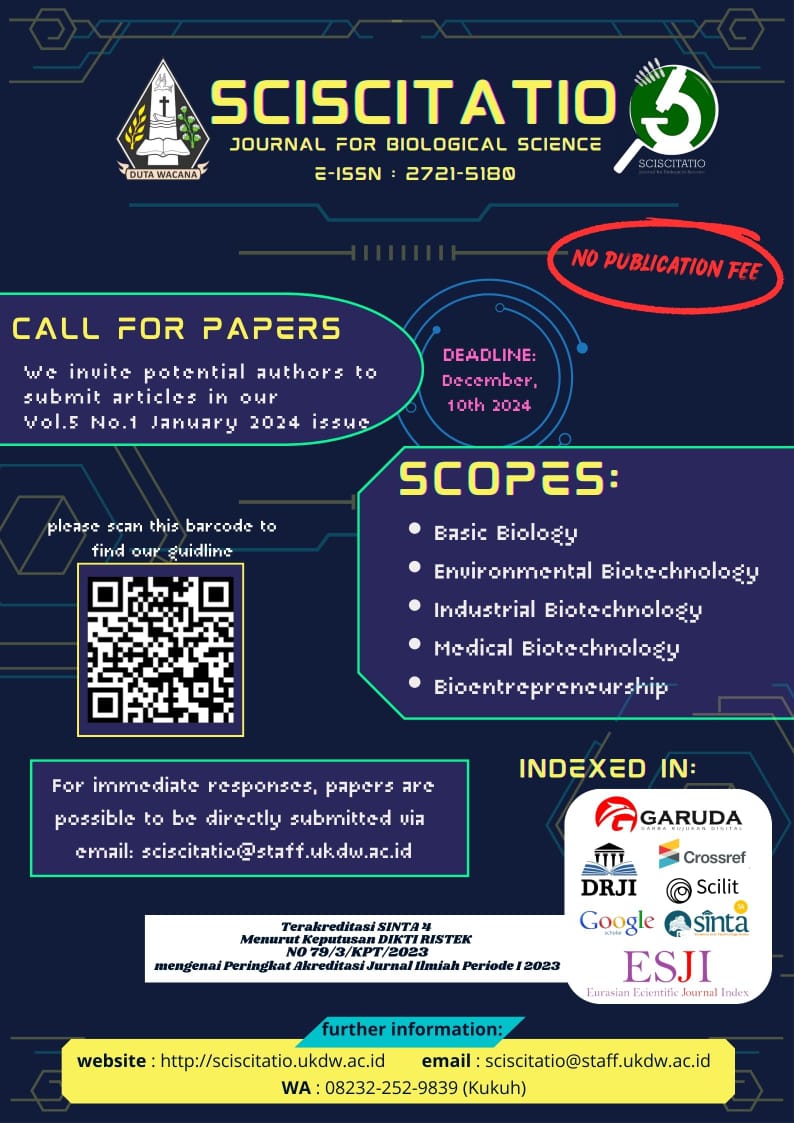Uji Antifungi Susu Fermentasi Komersial pada Candida non-albicans
DOI:
https://doi.org/10.21460/sciscitatio.2020.11.18Keywords:
susu fermentasi, Candida non-albicans, bakteri asam laktatAbstract
Bakteri Asam Laktat (BAL) yang terkandung dalam susu fermentasi akan menghasilkan asam-asam organik, hidrogen peroksida, diasetil, asetaldehid, asetoin, reutinin, reuterisiklin dan bakteriosin, dapat sebagai anti-Candida. Spesies Candida non-albicans seperti C. tropicalis dan C. glabrata sebagai penyebab kandidiasis oral cenderung meningkat. Tujuan penelitian ini mengetahui aktivitas antifungi susu fermentasi komersial pada Candida non-albicans dan viabilitas bakteri asam laktat di dalam susu fermentasi komersial. Aktivitas antifungi pada Candida non-albicans dilakukan dengan metode difusi sumuran. Viabilitas bakteri asam laktat dihitung berdasarkan jumlah bakteri asam laktat sebagai jumlah bakteri total (Total Plate Count). Hasil penelitian menunjukkan bahwa susu fermentasi komersial lebih mampu menghambat C. tropicalis dibandingkan C. glabrata. Viabilitas bakteri asam laktat dalam susu fermentasi komersial 107-1010 CFU/mL.
References
Adriani, L. ( 2010). Yoghurt Sebagai Probiotik. Dalam: Soeharsono (eds), Probiotik. Widya Padjadjaran, Bandung, hlm 117-130.
Adeniyi, B & Damsa, I. (2011). Antifungal Capacity of Lactic Acid Bacteria Isolated From Salad Vegetables. Afr. J. Biomed. Res., 14, 137-141.
Akalin, A.S., Fenderya, S., & Akbulut, N. (2004). Viability and Activity of Bifidobacteria in Yoghurt Containing Fructooligosaccharide During Refrigerated Storage. International Journal of Food Science and Technology, 39, 613-621.
Bamise, C.T & Bamise, O.F. (2008). Quantifying The Acidic Content of Commercial Yoghurt Drinks in Nigeria. Int. J. Dent. Sci., 6 (1), 16.
Biyari, S & Fozouni, L. (2018). The Inhibitory Effect of Probiotic Bacteria against Drug – Resistant Candida Species Isolated from the Oral Cavity of the Elderly. Shiraz E-Med J., 16 (6), 1-7.
Bulgasem, Y.B., Lani, M.Z., Hassan, Z., Yusofi, W.M.W., & Fnaish, S.G. (2016). Antifungal Activity of Lactic Acid Bacteria Strains Isolated from Natural Honey against Pathogenic Candida spesies. Mycobiology, 44 (4), 302-309.
Bulgasem, B.Y., Hassan, Z., Huda-Faujan, N., Omar, R.H.A., Lani, M.N., & Alshelmani, M.I. (2017). Effect of pH, Heat Treatment and Enzymes on The Antifungal Activity of Lactic Acid Bacteria Against Candida Species. Malaysian Journal of Microbiology, 13 (3), 195-202.
Coman, M.M., Verdenelli, M.C., Cecchini, C., Silvi, S., Orpianesi, C., Boyko, N., & Cresci, A. (2014). In Vitro Evaluation of Antimicrobial Activity of Lactobacillus rhamnosus IMC 501®, Lactobacillus paracasei IMC 502® and SYNBIO®. Journal of Applied Microbiology 117, 518527.
da Silva, D.C.G., Brugnera, D.F., & de Abreu, L.R. (2013). Quantification of Lactic Acid Bacteria and Bifidobacteria in Goat Milk Based Yoghurts with Added Water-Soluble Soy Extract. Afr. J. Food Sci., 7, 10, 392-398.
Gravina, H.G., de Morán, E.G., Zambrano, O., Chourio, M.L., de Valero, S.R., Robertis, S., & Mesa L. (2007). Oral Candidiasis in Children and Adolescents with Cancer. Identification of Candida spp.. Med Oral Patol Oral Cir Bucal., 12, E419-E423.
Guevarra, R.B., Virginia, L., & Barraquio. (2015). Viable Counts of Lactic Acid Bacteria in Philippine Commercial Yoghurts. Int J Dairy Sci Process, 2, 5, 24-28.
Hakim, L & Ramadhian, M.R. (2015). Kandidiasis Oral. Majority, 4 (8), 53-57. Hartayanie, L., Lindayani., & Murniati, M.P. (2015). Isolasi dan Identifikasi Bakteri Asam Laktat dari Asinan Rebung Bambu Betung yang Difermentasi pada Suhu 15°C. Dalam: Kusumaningrum, H.P.,Lindyani, Nurjanah, S., Rukmi, MG.I., & Gunawan, I. (eds). Prosiding Pertemuan Ilmiah Tahunan Perhimpunan Mikrobiologi Indonesia, 8-9 Oktober, Permi, Semarang, hlm. 216-223.
Hasrulliana, N,W., Suyoso, S., & Rosita, C.S.P. (2010). Surabaya Manifestasi Klinis dan Identifikasi Spesies Penyebab Kandidiasis Oral pada Pasien HIV/ AIDS RSUD Dr.Soetomo Surabaya. Berkala Ilmu Kesehatan Kulit & Kelamin, 22,1, 11-16. Irianto, K. (2013). Mikrobiologi Medis. Alfabeta, Bandung. Hlm 363-364.
Khalil, Md. I & Anwar, Md. N. (2016). Isolation, Identification and Characterization of Lactic Acid Bacteria from Milk and Yoghurts. RRJFPDT, 4, 3, 17-26.
Khikmah, N & Sulistyani, N. (2017). Potensi Beberapa Susu Fermentasi Komersial Sebagai Antifungi Candida albicans. Biota, 2 (1), 14-20.
Lukisari, C., Setyaningtyas, D., & Djamhari, M. (2010). Penatalaksanaan Kandidiasi Oral disebabkan Candida tropicalis pada Anak dengan Gangguan Sistemik. Dentofasial, 9 (2): 78-85.
Magnusson, J & Schnurer, J. (2001). Lactobacillus coryniformis subsp. coryniformis strain Si3 Produced a BroadSpectrum Proteinaceous Antifungal Compound. Appl. Environ. Microbiol., 67 (1), 1-5.
[NCCLS] National Committee for Clinical Laboratory Standard. (2002). Performance Standart for Antimicrobial Disc Susceptibility Testing. Twelfth International Supplement.
Parada, J.L., Caron, C.R., Medeiros, A.D.P. ,& Soccol, C.R. (2007). Bacteriocins from Lactic Acid Bacteria: Purification, Properties and Use as Biopreservatives. Braz Arch Biol. Tech., 50, 521-524.
Pfaller, M.A & Diekema, J.D. (2007). Epidemiology of Invasive Candidiasis: a Persistent Public Health Problem. Clinical Microbiology Reviews, 20 (1), 133-63. Purwijantiningsih, E. (2011). Uji Antibakteri Yoghurt Sinbiotik Terhadap Beberapa Bakteri Patogen Enterik. Biota, 16 (2), 173-177.
Rahayu, E.S., Yogeswara, A., Mariyatun, Haryono, P., Utami, I.S., Utami, T., Nurfiani, S., & Cahyanto, M.N. (2013). Bakteri Asam Laktat Indigenous Berpotensi Probiotik Dan Aplikasinya Untuk Produksi Susu Fermentasi. Dalam: Karmiadji, D.W., Gunadi, A.D., Soebagyo, H., & Fazri, R. (eds). Prosiding Seminar Intensif Riset SINas, 7-8 November 2013, Kemristek, Jakarta, hlm. 149-159.
Rai, A.K., Bhaskar, N., Amani, P.M., Indriani, K., Suresh, P.V., & Mahendrakar, N.S. (2009). Characterization and Aplication of Native Lactic Acid Bacterium Isolated From Tannery Fleshing for Fermentative Bioconversion of Tannery Fleshing. Application Microbiology Biotechnology, 83, 757-766.
Suskovic, J., Kos, B., Beganovic, J., Pavunc, A.L., Habjanic, K., & Matosic, S. (2010). Antimicrobial Activity-The Most Important Property of Probiotic and
Stater Lactic Acid Bacteria. Food Technol. Biotechnol., 48, 3, 296-307. Shah, N.P. (2000). Probiotic Bacteria : Selective Enumeration and Survival in Dairy Food. Dairy Science J., 5: 515-521. Urbiene, S & Leskauskaite, D. (2006). Formation of Some Organic Acids During Fermentation of Milk. Pol. J. Food. Nutr. Sci., 15/16, 3, 277-281.
Walangare, T., Hidayat, T., & Basuki, S. (2014). Profil Spesies Candida pada Pasien Kandidiasis Oral dengan Infeksi HIV & AIDS. Berkala Ilmu Kesehatan Kulit & Kelamin, 26, 1, 29-35.
Wibowo, W. (2002). Bioteknologi Fermentasi Susu. Pusat Pengembangan Bioteknologi. Universitas Muhammadiyah Malang


